with 的复合结构
with复合结构例句

with复合结构例句
with的8种复合结构用法例句如下所示:
1、with +宾语+名词
He died with his daughter a schoolgirl.他在他女儿是个小学生的时候死了。
2、with+名词(或代词)+补语
He wondered if he could slide out of the lecture hall without anyone noticing.他想他是否可以在没有人注意到他的情况下悄悄溜出演讲大厅。
3、with +名词(或代词)+过去分词
She had to walk home with her bike stolen.自行车被偷,她只好步行回家。
4、with +名词(或代词)+现在分词
With the crowds cheering, they drove to the palace.在人群的欢呼声中,他们驱车来到皇宫。
5、with+名词(或代词)+非谓语动词
With a lot of work to do, he wasn't allowed to go out.因为还有很多工作要做,他没有被允许外出。
6、with+名词(或代词)+介词短语
He walked into the dark street with a stick in his hand.他走进黑暗的街道时手里拿着根棍子。
7、with+名词(或代词)+副词
She left the room with all the lights on.她离开了房间,灯还亮着。
8、with+名词(或代词)+形容词
I like to sleep with the windows open.我喜欢把窗户开着睡觉。
With的复合结构

She lives in the room with
她住在亮着灯的那个房间里。
the light
burning.
一、With复合结构的构成
2.with + 名词(n.)/ 代词(pron.) + 不ቤተ መጻሕፍቲ ባይዱ式(to do),动词不定式表示目的,
或将发生而未发生的事。(动作尚未发生)
eg: The Human Genome Project, launched in 1990 with a mission to decode the
我没有事可做,只好睡觉。
一、With复合结构的构成
3.with + 名词(n.)/ 代词(pron.) + 形容词(adj.)
eg:
She lay in bed with her face pale.
她躺在床上,脸色苍白。
He used to sleep with all the windows open.
With的复合结构
5.表示结果
eg:
The battle ended with the enemy defeated. 战斗结束了,敌人被打败了。 They have finished the peace talks with the agreements reached. 他们结束了和谈,达成了协议。
With的复合结构
With的复合结构
With的复合结构有以下5种表现形式,即: 1.with + 名词(n.)/ 代词(pron.) + 分词 (过去分词(done)/现在分词 (doing)); 2.with + 名词(n.)/ 代词(pron.) + 不定式(to do); 3.with + 名词(n.)/ 代词(pron.) + 形容词(adj.); 4.with + 名词(n.)/ 代词(pron.) + 副词(adv.); 5.with + 名词(n.)/ 代词(pron.) + 介词短语(prep. phrase)。 With的复合结构在句子中可作定语或状语。
with复合结构的常见形式
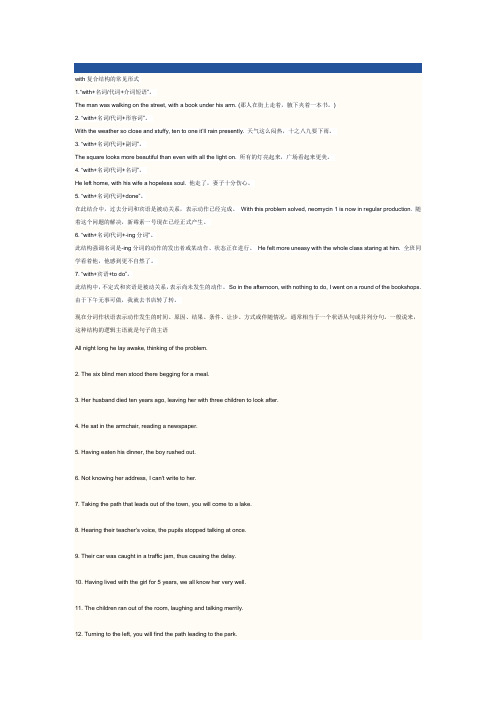
with复合结构的常见形式1.“with+名词/代词+介词短语”。
The man was walking on the street, with a book under his arm. (那人在街上走着,腋下夹着一本书。
)2. “with+名词/代词+形容词”。
With the weather so close and stuffy, ten to one it’ll rain presently. 天气这么闷热,十之八九要下雨。
3. “with+名词/代词+副词”。
The square looks more beautiful than even with all the light on. 所有的灯亮起来,广场看起来更美。
4. “with+名词/代词+名词”。
He left home, with his wife a hopeless soul. 他走了,妻子十分伤心。
5. “with+名词/代词+done”。
在此结合中,过去分词和宾语是被动关系,表示动作已经完成。
With this problem solved, neomycin 1 is now in regular production. 随着这个问题的解决,新霉素一号现在已经正式产生。
6. “with+名词/代词+-ing分词”。
此结构强调名词是-ing分词的动作的发出者或某动作、状态正在进行。
He felt more uneasy with the whole class staring at him. 全班同学看着他,他感到更不自然了。
7. “with+宾语+to do”。
此结构中,不定式和宾语是被动关系,表示尚未发生的动作。
So in the afternoon, with nothing to do, I went on a round of the bookshops. 由于下午无事可做,我就去书店转了转。
现在分词作状语表示动作发生的时间、原因、结果、条件、让步、方式或伴随情况,通常相当于一个状语从句或并列分句。
with 的复合结构和独立主格
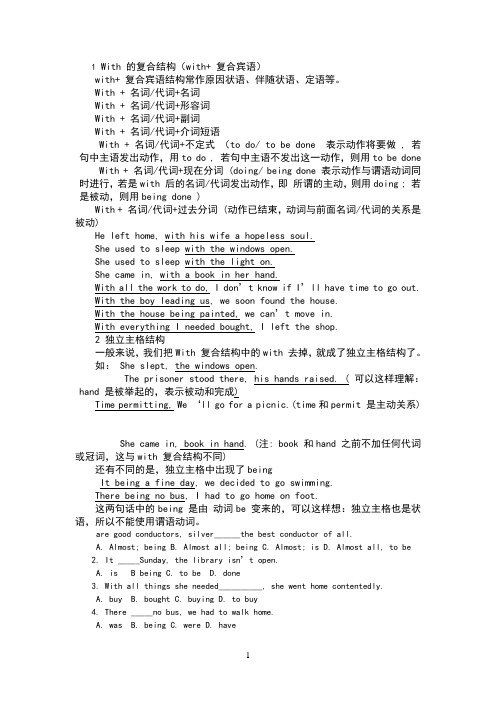
1 With 的复合结构(with+ 复合宾语)with+ 复合宾语结构常作原因状语、伴随状语、定语等。
With + 名词/代词+名词With + 名词/代词+形容词With + 名词/代词+副词With + 名词/代词+介词短语With + 名词/代词+不定式(to do/ to be done 表示动作将要做 , 若句中主语发出动作,用to do , 若句中主语不发出这一动作,则用to be done With + 名词/代词+现在分词 (doing/ being done 表示动作与谓语动词同时进行,若是with 后的名词/代词发出动作,即所谓的主动,则用doing ; 若是被动,则用being done )With + 名词/代词+过去分词 (动作已结束,动词与前面名词/代词的关系是被动)He left home, with his wife a hopeless soul.She used to sleep with the windows open.She used to sleep with the light on.She came in, with a book in her hand.With all the work to do, I don’t know if I’ll have time to go out.With the boy leading us, we soon found the house.With the house being painted, we can’t move in.With everything I needed bought, I left the shop.2 独立主格结构一般来说,我们把With 复合结构中的with 去掉,就成了独立主格结构了。
如: She slept, the windows open.The prisoner stood there, his hands raised. ( 可以这样理解:hand 是被举起的,表示被动和完成)Time permitting, We ‘ll go for a picnic.(time和permit 是主动关系)She came in, book in hand. (注: book 和hand 之前不加任何代词或冠词,这与with 复合结构不同)还有不同的是,独立主格中出现了beingIt being a fine day, we decided to go swimming.There being no bus, I had to go home on foot.这两句话中的being 是由动词be 变来的,可以这样想:独立主格也是状语,所以不能使用谓语动词。
with的复合结构的用法

I had to go to bed with nothing to do. 我没有事可做,只好睡觉。
4. with+宾语+ 介词短语 The teacher came in with a book in his hand. 老师进来了,手里拿着本书。
战斗结束了,敌人被打败了。
They have finished the peace talks with the agreements reached.
Exercise:
1.With the boy _l_e_a_d_in_g____the way,we found he house easily. (lead)
• 3. 表示时间
• The children began to watch TV with the homework done.
• 孩子们完成作业以后开始看电 视。
• The meeting was over with the problem settled.
• 问题解决以后,会议结束了。
4. 表示条件
with复合结构
一、with复合结构: “with+宾语+宾语补足语” 此结构在句中常作状语,可位于句首或句尾,
常作时间、原因、方式、伴随状语,亦可作后置 定语。 二、 with复合结构的构成 1. with+宾语+adj.(adj.表状态)
He used to sleep with all the windows open. 他过去常常开着窗子睡觉。
(小男孩已领过路) 2.With the boy _t_o_l_e_a_d_______the way,we
with的复合结构

with的复合结构精华知识一. with复合结构的构成1. with+宾语+名词He died with his daughter yet a school girl. 他死的时候,他的女儿还是个学生。
2. with+宾语+形容词He used to sleep with all the windows open. 他过去常常开着窗子睡觉。
She lay in bed with her face pale. 她躺在床上,脸色苍白。
3. with+宾语+副词The girl fell asleep with the light on. 那位女孩睡着了,灯还亮着。
Her mother sat in an armchair with her head down. 她母亲坐在椅子上,头低着。
Anderson was lying on the bed with all his clothes on.4. with+宾语+不定式(不定式做宾补有“将来”的含义)I can’t go out with these clothes to wash. 因为这些衣服要洗,我不能出去。
I had to go to bed with nothing to do. 我没有事可做,只好睡觉。
5. with+宾语+介词短语He sat near the fire with his back to the door. 他坐在炉子旁,背朝着房门。
The teacher came in with a book in his hand. 老师进来了,手里拿着本书。
He was asleep with his head on his arms.6. with+宾语+现在分词(宾语与宾补之间是主动关系)With the machine helping us, we could finish the work on time. 由于有机器的帮助,我们能按时完成任务。
With的复合结构
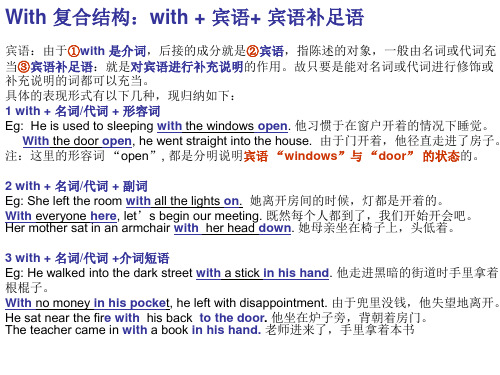
4 with + 名词/代词 +不定式 Eg: With the boy to lead the way,we will find the house easily tomorrow.(小男孩明天将领 路) With so much work to do, I have no time for a holiday. 因为有很多工作要做,我没时 间度假。 With many new words to remember, she will stay up tonight. 由于要记很多生词,她今 晚打算熬夜。 注:用不定式这一结构时,表示得是将要发生的事情。 5 with + 名词/代词 +V-ing Eg: With the little boy leading the way, we found the house easily. 因为有小男孩带路, 我们很容易就找到了那个房子。 With nobody watching TV, I switched off it. 由于没人看电视,我就把电视关了。 I’d like to see the new film with time permitting.如果时间许可,我想看那部新电影。 With the machine helping us, we could finish the work on time. 由于有机器的帮助,我们能按时完成任务。 She lives in the room with the light burning.她住在亮着灯的那个房间里。
9.________two exams to worry about, I have to work really hard this weekend. (2004年北京卷) A. B. Besides √ With C. As for D. Because of 10. It was a pity that the great writer died________ his work unfinished. (2004年福建卷) A. for B. C. from D. of √ with
With的复合结构超全

3.with + 宾语 + 介词短语
The teacher came in with a book in his hand. 老师手里拿着书走进来。
The girl looked up with tears in her eyes. 那女孩眼泪汪汪地抬起头。
4.with + 宾语 + 名词 They set up a football team, with Tom their head. 他们建立了一支足球队,汤姆当队长。 With a native our guide, we needn't be afraid to get lost. 有本地人当向导,我们不必担心会迷路。
5.with + 宾语 + 现在分词 (主谓关系) With summer coming, the weather is becoming hotter and hotter. 随着夏天的到来,天气越来越热。 With the teacher standing beside, she felt a bit uneasy . 老师站在旁边,她觉得有点不自然。
“with复合结构”,即
“with + 宾语 + 补足语”,
在英语中,特别是在书面语中是一个很 常用的结构,它既可以充当状语,又可 以充当定语。由于“with复合结构”在 逻辑上是一个主谓关系完整的结构,因 而,它也可以用相应的从句或分句代替。
一、“with复合结构”的构成
with + 宾语 +
形容词 副词 名词 介词短语 v-ing 主动、进行 v-ed 被动、完成 to do 将要发生
1.with + 宾语 + 副词 The square looks more beautiful with all the lights on. 所有的灯都亮时,广场显得更加美丽。 With his parents away, Tom becomes more naughty.
高中英语with 的复合结构
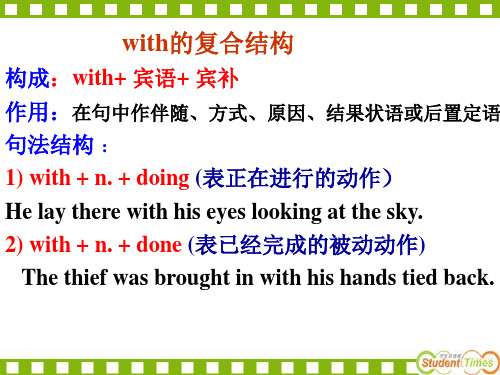
1)He sat there thinking, with his chin__o_n__(prep.在..上)
his hand.
open
2)He stared at his friend with his mouth wide_____(adj.
张开)
3) With production __u_p__(adv.上升)by 60%, the company has had another excellent year .
5) with + n. + adj When he is eating, he doesn’t speak with his mouth full of food.
6) With + n. + adv. He went to bed with the light on.
Exercises:
1.填空
6. With 10 minutes__t_o__g(ogo), you’d better hurry.
7. With so many problems _to__s_o_lv(esolve), the newlyelected president is going to have a hard time.
4)She stood there chatting with her friend, with her child p_l_a_y_in_g(play)beside her.
5.
“I think we can leave Eriksson said.
with
our
heads
_h_e_ld__(hold)high,”
The thief was brought in with his hands tied back.
英语必修一语法——with的复合结构

With 的复合结构:的复合结构:With +宾语+宾补:表明状态、说明背景情况一般在句中做伴随,方式,原因,条件状语。
宾补:表明状态、说明背景情况一般在句中做伴随,方式,原因,条件状语。
With my son a baby, I came back to work. With a dream in my heart, I worked very hard. With a lot of work to do, I always forget to miss him. With the night falling, I began to miss him. With everything done, I went to bed. With the light off, I held my telephone and saw his photos. With my eyes red, I fell asleep. 可以看出可以看出With+宾语+宾补可名词,介词,不定式,现在分词,过去分词,副词,形容词来充当。
各自有相应的特点名表示状态,介词表地点,要做,主动,被动,状态,有相应的特点名表示状态,介词表地点,要做,主动,被动,状态,翻译下列句子:翻译下列句子:1. He died __________________________________. 他死时女儿还是个学生。
他死时女儿还是个学生。
2. She stood at the door,_______________________. 她站在文库,背对着我们。
她站在文库,背对着我们。
3._________________,we are sure to finish the work ahead of me. 有李先生帮忙,我们一定能提前完成工作。
有李先生帮忙,我们一定能提前完成工作。
4. He lay on the grass ___________________________. 他躺在草地上,两眼望着天空。
with的复合结构

课堂演练汉译英
13.他两手交叉着坐在那里。 He sat there with his hands crossed. 14.爸爸站在窗前,眼睛凝视外面。 Dad stood in front of the window with his eyes staring outside. 15.作业做完了,他们就回家了。 With their assignment finished , they went home. 16.妹妹坐在树下,头上戴着一顶帽子。 My sister sat under the tree with a hat on her head. 17.弟弟跑进房间,手里拿着一瓶啤酒。 My brother ran into the room with a bottle of beer in his hand.
二.作定语
修饰名词 23.我喜欢上面有花的图案的卡片。 I like cards with flowers design on them. 这个著名的画家住在一所树木环绕的房子里。 24.The famous artist lives in a house with trees surrounding it.
18.他穿着鞋子睡着了。 He fell asleep with shoes on. 19.那个乞丐坐在角落里,前面放着一个破碗。 The beggar sat in the corner with a torn /cracked bowl in front of him. 20.一阵微风吹来,我感觉舒服多了。 With a breeze blowing , I felt more comfortable. 21.这么多人吵闹,我们不能学习。 With so many people making noise,we couldn't study. 22.妈妈呆在家里,门关上了。 Mum stayed home with the door shut.
高中英语 With的复合结构

1)With nothing _______ to burn,
the fire became weak and finally
died out.
A. leaving
B. left
C. leave
D. to leave
2)The girl sat there quite silent
and still with her eyes _______ on
The room with lights on is our classroom . 开着灯的那个教室是我们的。
除此以外,“with复合结构”还有其否定 形式,即“without + 宾语 + 补足语” The house caught a big fire last night, without anything left in it. = The house caught a big fire last night, with nothing left in it. They finished the work without anyone helping them. = They finished the work with no one helping them.
the wall.
A. fixing
B. fixed
C. to be fixing D. to be fixed
3)I live in the house with its door _________ to the south.(这里with结构 作定语)
A. facing
B. faces
C. faced
2)She sat w__it_h__h_e_r_h_e_a_d__b_e_n_t (低着头).
英语With的复合结构

With的复合结构With复合结构,是由with+宾语+宾补组成,在句中常做状语,如伴随、时间、原因、方式状语等,也可以做定语。
1.with+名词(或代词)+名词there is a tallng am “B s H s ”.B g s a s r.他们住在北京,他们的儿子是个士兵。
2) He died s a a s -girl.他去逝时,女儿还是个小学生。
3) He lived a rich life, s a a a .他过着富足的生活,而他的老父亲却沿街乞讨。
2.with+名词(或代词)+形容词强调名词的特性或状态She came into the room,with her nose red a s e of cold.1s open.我喜欢把窗户开着睡觉。
(伴)2) D ’ a with your mouth full.嘴里有食物时不要讲话。
(伴)3.with+名词(或代词)+副词With the meal over ,we all went home.a with the light on.他睡着了,灯还亮着。
(伴)2) The boy stood there with his head down.这个男孩低头站在那儿。
(伴)4.with+名词(或代词)+介词短语Do you know the woman with a baby in her arms(=who has ababy in her arms)?a a a a a on when we want to.由于孩子们在上学,所以当我们想度假时而不能去度假。
(原)a a a a .士兵让他背朝着他的父亲站在那儿。
(方)5.with+名词(或代词)+动词不定式此时,不定式表示将发生的动作。
With the boy to lead the way,we will find the house easm ow.1) With no one to talk to, John felt upset.由于没人可以说话的人,约翰感到很焦虑。
with 的复合结构和独立主格
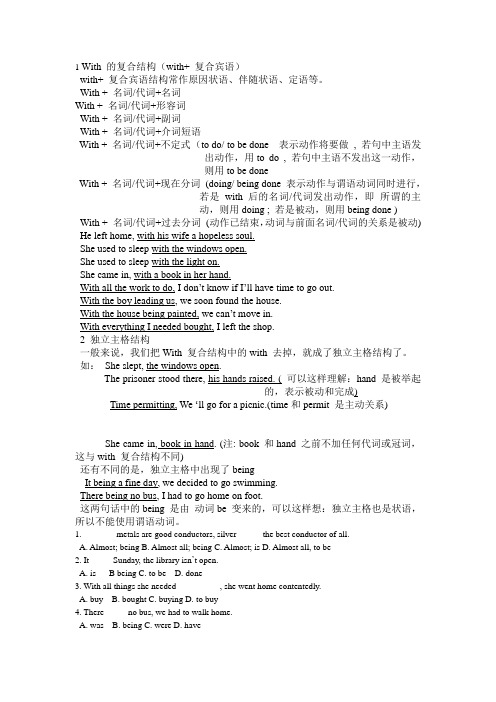
1 With 的复合结构(with+ 复合宾语)with+ 复合宾语结构常作原因状语、伴随状语、定语等。
With + 名词/代词+名词With + 名词/代词+形容词With + 名词/代词+副词With + 名词/代词+介词短语With + 名词/代词+不定式(to do/ to be done 表示动作将要做, 若句中主语发出动作,用to do , 若句中主语不发出这一动作,则用to be doneWith + 名词/代词+现在分词(doing/ being done 表示动作与谓语动词同时进行,若是with 后的名词/代词发出动作,即所谓的主动,则用doing ; 若是被动,则用being done )With + 名词/代词+过去分词(动作已结束,动词与前面名词/代词的关系是被动) He left home, with his wife a hopeless soul.She used to sleep with the windows open.She used to sleep with the light on.She came in, with a book in her hand.With all the work to do, I don’t know if I’ll have time to go out.With the boy leading us, we soon found the house.With the house being painted, we can’t move in.With everything I needed bought, I left the shop.2 独立主格结构一般来说,我们把With 复合结构中的with 去掉,就成了独立主格结构了。
如:She slept, the windows open.The prisoner stood there, his hands raised. ( 可以这样理解:hand 是被举起的,表示被动和完成)Time permitting, We ‘ll go for a picnic.(time和permit 是主动关系)She came in, book in hand. (注: book 和hand 之前不加任何代词或冠词,这与with 复合结构不同)还有不同的是,独立主格中出现了beingIt being a fine day, we decided to go swimming.There being no bus, I had to go home on foot.这两句话中的being 是由动词be 变来的,可以这样想:独立主格也是状语,所以不能使用谓语动词。
With的复合结构-上课用

把下列句子中的划线部分改写成with复合结构。
①Because lessons were over, we With ourour lessons over, went to play football.
②The children came running towards With some flowers in their us and held some flowers in theirhands. hands.
父母不在,汤姆变得更淘气。
2. with + 宾语 + 形容词 With the door and windows open wide, the room was very cold.
门窗大开,屋内很冷。
With her parents dead, the girl had to left school. 她父母死了,那女孩只好辍学。
5.with + 宾语 + 现在分词 (主谓关系) With summer coming, the weather is becoming hotter and hotter. 随着夏天的到来,天气越来越热。 With the teacher standing beside, she felt a bit uneasy . 老师站在旁边,她觉得有点不自然。
用with复合结构翻译句子
1. 他经常开着窗户睡觉。 He always sleeps with the window open. 2. 他睡着了,灯还开着。 He fell asleep, with the lights still on. 3. 老师走进来,手里拿着本书。 The teacher came in, with a book in his hand.
- 1、下载文档前请自行甄别文档内容的完整性,平台不提供额外的编辑、内容补充、找答案等附加服务。
- 2、"仅部分预览"的文档,不可在线预览部分如存在完整性等问题,可反馈申请退款(可完整预览的文档不适用该条件!)。
- 3、如文档侵犯您的权益,请联系客服反馈,我们会尽快为您处理(人工客服工作时间:9:00-18:30)。
with without 引导的独立主格结构介词with without +宾语+宾语的补足语可以构成独立主格结构,上面讨论过的独立主格结构的几种情况在此结构中都能体现。
A.with+名词代词+形容词He doesn’t like to sleep with the windows open.他不喜欢开着窗子睡觉。
= He doesn’t like to sleep when the windows are open.He stood in the rain, with his clothes wet.他站在雨中,衣服湿透了。
= He stood in the rain, and his clothes were wet.注意:在“with+名词代词+形容词”构成的独立主格结构中,也可用已形容词化的-ing 形式或-ed形式。
With his son so disappointing,the old man felt unhappy.由于儿子如此令人失望,老人感到很不快乐。
With his father well-known, the boy didn’t want to study.父亲如此出名,儿子不想读书。
B.with+名词代词+副词Our school looks even more beautiful with all the lights on.所有的灯都打开时,我们的学校看上去更美。
= Our school looks even more beautiful if when all the lights are on.The boy was walking, with his father ahead.父亲在前,小孩在后走着。
= The boy was walking and his father was ahead.C.with+名词代词+介词短语He stood at the door, with a computer in his hand. 或He stood at the door, computer in hand.他站在门口,手里拿着一部电脑。
= He stood at the door, and a computer was in his hand.Vincent sat at the desk, with a pen in his mouth. 或Vincent sat at the desk, pen in mouth.文森特坐在课桌前,嘴里衔着一支笔。
= Vincent sat at the desk, and he had a pen in his mouth.D.with+名词代词+动词的-ed形式With his homework done, Peter went out to play.作业做好了,彼得出去玩了。
= When his homework was done, Peter went out to play.With the signal given, the train started.信号发出了,火车开始起动了。
= After the signal was given, the train started.I wouldn’t dare go home without the job finished.工作还没完成,我不敢回家。
= I wouldn’t dare go home because the job was not finished.E.with+名词代词+动词的-ing形式The man felt very happy with so many children sitting around him.有这么多的孩子坐在他周围,那男子感到很高兴。
= The man felt very happy when he found so many children sitting around him. The girl hid her box without anyone knowing where it was.小女孩把盒子藏了起来,没有人知道它在哪里。
= The girl hid her box and no one knew where it was.Without anyone noticing, he slipped through the window. 他趁没人注意的时候,从窗口溜走了。
= When no one was noticing, he slipped through the window.F.with+名词代词+动词不定式The little boy looks sad, with so much homework to do.有这么多的家庭作业要做,小男孩看上去很不开心。
= The little boy looks sad because he has so much homework to do.The kid feels excited with so many places of interest to visit.有这么多的名胜可参观,小孩很激动。
The kid feels excited as there are so many places of interest to visit.提示:在with without 的复合结构中,多数情况下with 能省略,但without 不能省略。
Without a word more spoken, she left the meeting room.她没再说什么话就离开了会议室。
(without不能省略)with+宾语+宾补有这些词和短语可以做宾补:1、形容词2、副词3、介词短语4、现在分词5过去分词6、不定式with the window closed(closed为形容词)with the light onwith a book in her handwith a cat lying in her armswith the problem solvedwith the new term to begin英语中“介词with + 复合宾语” 结构也叫介词with的复合结构, 即“with+ 宾语+ 宾语补足语”, 这种结构在中学英语课本中频频出现,用法十分灵活而且复杂。
近年来,高考命题者常常通过一定的语境来考查with这一复合结构的用法,下面让我们先看看两道与介词with复合结构相关的高考试题:1.(NMET.2000) _________ production up by 60 % , the company has had another excellent year.A. AsB. ForC. WithD. Through[解析] 答案C。
本题考查介词with的复合结构“with + n / pron + prep. phrase(介词短语)”的用法。
“as”作为连词,意为“因为、由于”,其后必须跟从句;作为介词,意为“作为”,从语法和句意方面都不能用。
而for和through在这里从语法和句意方面也不能用。
在这里应用with,意思是“因为、由于”。
句意是:由于生产(产品)上升了60% ,这家公司又有了一个辉煌年。
2.(Beijing. 2004) ________two exams to worry about , I have to work really hard this weekend.A. BesidesB. WithC. As forD. Because of[解析] 答案B。
这道题也是考查介词with复合结构用法的。
从句子的结构看这里必须要填一个介词,而不能填连词,“as for” 意思是“至于、关于”;because of意思是“由于、因为”,其后不能跟复合结构,所以不能选择C和D。
在所给的选项中只有with才符合构成“ with + n / pron + to do ”结构。
句意是:由于担心这两门考试,本周末我得真的用功了。
以上两道试题从不同的角度对介词with复合结构的用法进行了考查。
一般来说,with的复合结构在句子中主要用作状语,表示谓语动词的动作发生的伴随情况、时间、原因、方式等等。
为了帮助同学们更好地理解和掌握介词with的复合结构用法,笔者通过多年对介词的分析研究,依托高考经典试题,对介词with的用法作如下分析和归纳,供同学们参考:1>“with + n / pron + v-ing”这一结构在句子中作伴随状语,说明情况,其中现在分词表示主动或正在进行的动作。
例如:①________our food ________, we had to walk to a village for help.(成都毕业班第一次诊断试题)A. Since; runs outB. Because; run outC. With; running outD. For; running out[解析] 答案C。
“since、because、for”作“由于、因为”讲,是连词,其后只能跟从句,不能跟复合结构,所以不能选A、B、D。
由于run out是不及物动词短语且与our food之间存在主谓关系所以只能用running out 结构,with在这里表示原因,故答案是C。
句意是:在我们的食物快要用完的情况下,我们不得不向附近的村子求援。
②.When mother went into the house, she found her baby was sleeping in bed, ________ his lips moving.A. asB. withC. forD. through[解析] 答案B。
该题是考查介词短语用作状语用法的。
“as”作为连词,意为“因为、由于”,其后必须跟从句;作为介词,意为“作为”,从语法和句意方面都不符合;而for和through 在这里从语法和句意方面也不能用。
在所给的选项当中,只有with才可以构成这一复合结构,用作表示伴随情况的状语,故选B。
句意是:当妈妈走进房子的时候,她发现自己的孩子正睡在床上,嘴唇一直在动。
2>.“with + n / pron +v-ed. ”这一结构在句子中作原因状语,其中过去分词表示被动或完成了的动作。
例如:①---You should have prepared your speech for the meeting , Mrs Smith .---Yes, I know .But how could I ______the meeting date fixed so soon .(2005东北三校联考)A. whileB. asC. afterD. with[解析] 答案:D。
